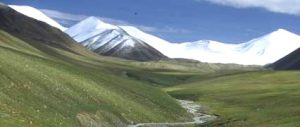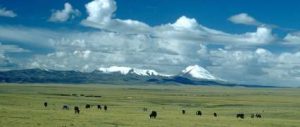High up where the Yangtze River rises on the Tibetan Plateau, the environment is “shocking,” said Xin Yuanhong, director of an environmental and geological survey of the area. The study, which took place from June 2005 to October 2008, found the area has been particularly affected by global warming; glaciers are receding, the permafrost is melting, the vegetation is dying off, the wetlandsa are drying up and water resources are disappearing.
The Tuotuo, Chuma’er and Dangqu rivers are known as the “three sources of the Yangtze River.” In 1978, a survey team reached the source of the Dangqu River, a stream on the side of Mount Xiasheriaba, which they identified as the source of the Yangtze River.
Xin went looking for that source in September 2006, but failed to find it. The receding glaciers meant that the source had disappeared. “Glaciers are known as solid reservoirs for rivers on the plateau,” Xin said. “Once the glaciers disappear once-permanent rivers will become seasonal or even dry up completely.”
Glacial retreat is common in the region. The glacier on the south side of Yuzhufeng, in the Kunlun Mountains, retreated 1,500 metres between 1971 and 2005. The edges of the glacier on the east side of the Tanggula pass have moved by 125 metres, with the tip of the glacier receding 265 metres.
Xin said there were lessons to be drawn from the fate of the Yellow River. He was part of a government study of the Yellow River source in 2000. “In 1969 there were glaciers there,” he said. “But in 2000 we couldn’t find a single one.”
Ecological catastrophes that once occurred at the source of the Yellow River are now being repeated at the head of the Yangtze River. In May 2007, Xin met a herder near the wetlands around Zhiduo and Qumalai, who was moving to live with his relatives. The grass his livestock had depended on was no longer growing; it had been replaced with a different species that neither cows nor sheep would touch, but that could survive the falling water tables. His team found that 98 of the 108 wells in the county of Qumalai had dried up in recent years. Half of the 4,077 lakes in Maduo had disappeared, and water levels in the others had dropped by two to three metres.
Changes in the permafrost, or frozen soil, were partly to blame. “Permafrost actually acts as a layer of waterproofing,” said Xin. “Experts say that it protects wetlands. As the permafrost thins, more surface water is absorbed – and if the permafrost disappears, the surface may dry out and become desert.”
The survey found patches of permafrost damage on the north and south edges of the plateau. In some areas it had completely disappeared. “Vegetation protects the permafrost like a blanket. And the permafrost retains surface water, which allows the vegetation to grow.” Xin drew a circular diagram to describe the relationship. “It’s a closed, fragile chain,” he said. In many locations, he has seen irreparable damage to its links.
In 2005, a road was built between Zhiduo and Suojia. A drainage channel was dug alongside the road, which exposed the permafrost to the elements. A year later it had melted and collapsed. Xin saw that the permafrost was still melting there in 2007. The road had to be re-routed – and then re-routed again after the same problem struck – causing great difficulty and financial loss. Road building over permafrost is a problem across the world. The Qinghai-Tibet highway, despite reconstruction and repair work, is at risk from the irreversible damage being done to the permafrost by global warming and a lack of understanding in the road’s initial construction.
The survey found many problems caused by human damage to the permafrost, including road building around the Chuma’er River plateau, the Wudaoliang basin, the Xiushui and Beilu rivers and the Tuotuo River basin. “When a road cuts through wetlands they get divided in two, cutting off the water supply for the downstream section, “ explained Xin. “Damage to the permafrost, caused by the building of the Qinghai-Tibet highway and railway – and the houses alongside them – has resulted in subsidence and can cause landslides.” The sides of the highway were the first area to be covered in the survey, since they are easy to reach. In many of these areas, subsidence has left buildings at risk of collapse.
Wetlands – the “kidneys of the world” — are a unique and resource-rich ecosystem. They absorb flood waters, moderate the climate and cleanse the environment. Xin said the degradation of the wetlands could lead to environmental disaster. The county seat of Qumalai has been moved twice due to a lack of water in the Tongtian River, a tributary of the Yangtze River. Even there at the head of the river, there is no water. Many wetland areas on the Dangqu River (which means “marsh river” in Tibetan) had dried up or receded. Nothing except rodents live on the bare earth left behind, and even that will erode and become desert.
The survey did not calculate how many residents were affected by these environmental changes. However, Xin said the team often met locals who complained of recent problems with drinking water and pasture for their livestock.
In Dangqu, Xin employed a local Tibetan as an assistant, who once told him: “We used to have lots of wetlands and thick tall grass on the pastures. If you went riding in the morning the dew would soak your boots. Now it doesn’t even cover the earth.”
Yang Jibin is a reporter for Southern Weekend.
This article first appeared in Southern Weekend.
Homepage photo by Daniel J Miller


